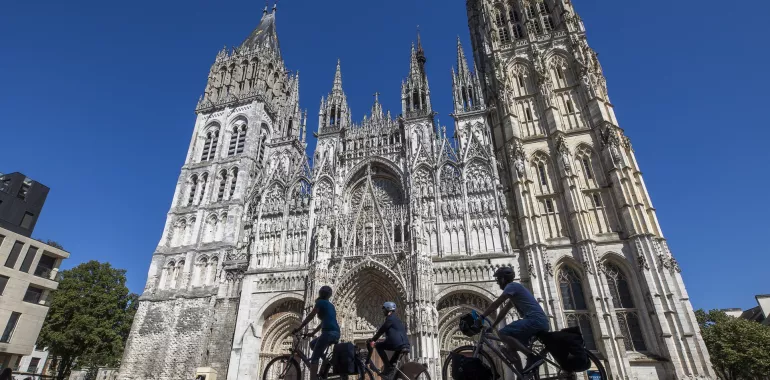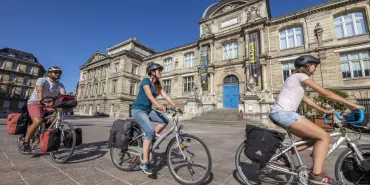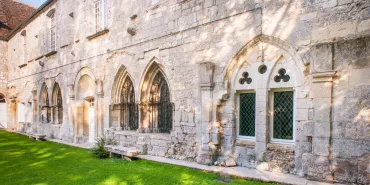Poses / Rouen La Seine à Vélo
45,18 km cycling route from Poses to Rouen
Elevation of the stage
Waytypes of the stage
Surface of the stage
The route
From Poses, the Seine à Vélo leads you alongside the Deux Amants Lake and Biotropica Park, on a track reserved for cyclists and walkers. Next, pass under a railway line and follow the Eure River via a lovely greenway to Pont-de-l’Arche. Then it’s minor roads from Pont-de-l’Arche to Criquebeuf-sur-Seine (with 800m on an earth track). To enter the town of Elbeuf, use the cycle lane beside the river, on the D921 road. At Elbeuf, a provisional stretch makes you cross the Seine via Guynemer Bridge – the definitive route will eventually take you across Pont Jaurès. Negotiate two further bridges before Orival, one a road bridge, the other a rail bridge looking down on the Seine; dismount for the latter, given its narrowness and the height of the guard rails. From Orival to Oissel, take care on the D18 road, even if the speed limit is 50kph along the eight kilometres. At Oissel, branch off in the direction of the hospital (via Rue Pierre Curie), then cross La Londe Rouvray via a surfaced track not open to motorized vehicles. There is quite a slope on a short stretch through forest, after taking a footbridge looking down on the dual carriageway, so keep one foot to the ground here. You emerge at the level of Rouen’s Zénith, a major venue. To reach the town centre, use the cycling facilities along the D938 road. At the rectangular round-about of Les Bruyères, continue along the D938, following directions for Rouen. Once you reach the Seine, cross the river via Pont Jeanne d’Arc, a bridge taking you into the city centre.
SNCF train stations
- Intercity and TER stations in Val de Reuil; Pont-de-l'Arche; Elbeuf Saint Aubin; Oissel
- TGV and TER train station in Rouen
- Réseau Astuce Rouen: Metro, bus, Fast, Téor serving the entire Rouen conurbation and the TAE network in Elbeuf serving the Elbeuvienne conurbation and the SNCF railway station located in Saint-Aubin-lès-Elbeuf.
- Long-distance coach station terminal: avenue Champlain (Paris, Caen, Lille)
Don’t miss
- Pont-de-l’Arche and Bonport Abbey: Beside the Seine, visit a Norman abbey founded by Richard Cœur de Lion. Located a one-hour cycle ride south of Rouen, in extensive grounds with views of the river, this Cistercian abbey was begun in 1189 for Richard the Lionheart, following an occasion when he almost drowned crossing the Seine. He made a vow that, if he arrived ‘à bon port’ (safely) on the other bank, he would have a monastery created on the spot. The abbey was sold off in 1791, during the Revolution. A number of the medieval monastic buildings have survived, including the chapterhouse, the work room, the cellar, the kitchens and the 13th-century vaulted refectory. Top tip: explore medieval Pont-de-l’Arche using the dedicated app.
- Circus theatre at Elbeuf: A rarity, with few equivalents in the world of entertainment, the Cirque-Théâtre d’Elbeuf, built in 1892, is one of just eight permanent circus buildings remaining in France. Reopened in 2007, this national centre for circus is a place for creation, production and discovery, as well as for shows and international artistic gatherings. The area having been awarded the label Villes et Pays d’Art et d’Histoire, cultural guided tours are also organized around here.
- Fabrique des Savoirs at Elbeuf (free entry): La Fabrique des Savoirs is run by the Métropole Rouen Normandie (covering the greater Rouen metropolitan area), and is located in the Blin Quarter of Elbeuf. It includes:
- the Musée d’Elbeuf: the Seine is the thread through the museum’s three main sections, divided between natural sciences, archaeology and industrial heritage.
- the Centre d’Archives Patrimoniales: this archive centre holds countless documents, many unique, proving essential sources of knowledge on the history of the parishes concerned and their inhabitants.
- the Centre d’Interprétation de l’Architecture et du Patrimoine: as part of the remit for being awarded Villes et Pays d’Art et d’Histoire status, this place presents a permanent exhibition on the urban and architectural development of the Elbeuf area, with models and audiovisual presentations. - Cathédrale Notre Dame de Rouen: In Rouen’s historic heart, the cathedral offers a fine lesson in the development of Gothic architecture, going from the start of construction in the 12th century, on the foundations of a basilica dating back to the 4th century and a later, Romanesque ensemble from the 11th century. The Vikings had destroyed an earlier church here in 841. In 1944, during World War II, Allied bombs partially destroyed the cathedral. This living momument has changed a lot through time. The metal spire, the tallest in France at 151m, dates from the 19th century. One constant: this is the only cathedral in France to have an adjoining archbishops’ palace still occupied by an archbishop. In the cathedral choir stand the tombs of the Dukes of Normandy, including that of the duchy’s founder, in 911, the Viking Rollo, and that of Richard the Lionheart, King of England as well as Duke of Normandy.
- Le Gros Horloge: A symbol of Rouen, straddling the main, pedestrian shopping street, the architectural ensemble of the Gros Horloge consists of a Gothic belfry, a great arch, a Renaissance clock and an 18th-century fountain. The belfry contains the town bells as well as one of the oldest clock mechanisms in Europe, operational from the 14th century to 1928. Inside, contemporary displays reveal the inner workings of this exceptional monument dedicated to time. Enjoy the dials room, the historic apartments of the clock’s governor, the original town bells and a unique view over the centre of town.
- Quartier des Antiquaires (Saint Maclou): Just east of the cathedral, the cobbled streets of the Quartier Saint Maclou are a joy to explore, with splendid shops and restaurants in magnificent timber-frame houses. Your pedestrian route can lead you up via Place du Lieutenant Aubert to view the great Abbatiale Saint-Ouen, then back down to Place Barthélémy, to admire the Church of Saint-Maclou, its Gothic façade like stone lace. Note the narrow passageways leading off the main streets, a reminder of medieval Rouen. Explore these hidden corners, unearthing architectural treasures. Don’t miss the amazing, restored Aitre Saint Maclou, site of a medieval cemetery, now a normally peaceful, if startling, courtyard.
- Joan of Arc: Joan of Arc is an iconic figure for the city. She is recalled in many streets, squares and monuments around Normandy’s capital. From the Tour de la Pucelle, via Place du Vieux Marché and the Cathédrale Notre-Dame, a trail leads you to the places in town closely associated with her and her fiery death here.
- Historial Jeanne d’Arc in Rouen: This museum dedicated to Joan of Arc lies within the archbishops’ palace, which includes the remnants of the Salle de l’Officialité, where Joan was condemned to death in 1431, but where her second, posthumous trial also took place in 1456, annuling the first. The Historial’s contemporary presentations retrace the many sides to Joan and the many stories associated her, using new technology in a medieval setting.
- Musée des Beaux-Arts: Rouen’s fine arts museum opened in 1809. It’s now considered one of France’s leading museums thanks to its rich collections, covering all periods from the 16th to the 19th centuries, in painting, drawing, sculpture and the decorative arts. Look out for pieces by Caravaggio, Vélasquez, Poussin, Rubens, Puget, Delacroix, Géricault, Modigliani and Duchamp, among others. The museum also boasts the largest collection of Impressionist works outside Paris, with Monet, Pissarro, Renoir and Sisley among those represented. The interior architect Andrée Putman renovated the museum in 1994, creating spacious, luminous rooms, plus there’s a sculpture garden dedicated to contemplation and relaxation.



Travellers’ reviews